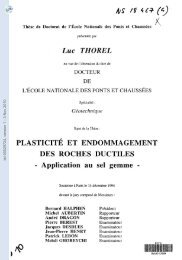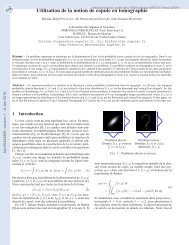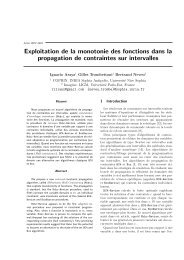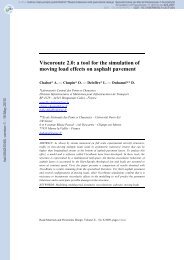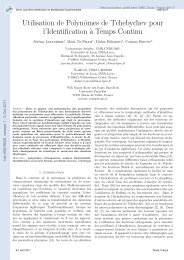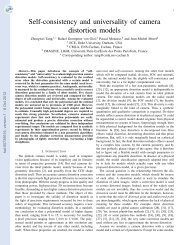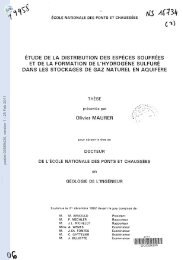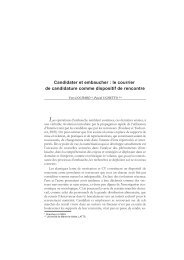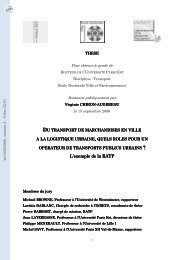Modelling plasticity of unsaturated soils - HAL ENPC
Modelling plasticity of unsaturated soils - HAL ENPC
Modelling plasticity of unsaturated soils - HAL ENPC
Create successful ePaper yourself
Turn your PDF publications into a flip-book with our unique Google optimized e-Paper software.
<strong>Modelling</strong> <strong>plasticity</strong> <strong>of</strong> <strong>unsaturated</strong> <strong>soils</strong> in a thermodynamically consistent<br />
framework<br />
Olivier COUSSY, Jean-Michel PEREIRA<br />
Université Paris-Est, UR Navier, École des Ponts ParisTech, Marne-la-Vallée, France.<br />
ABSTRACT<br />
Constitutive equations <strong>of</strong> <strong>unsaturated</strong> <strong>soils</strong> are <strong>of</strong>ten derived in a thermodynamically<br />
consistent framework through the use a unique ’effective’ interstitial pressure. This later is<br />
naturally chosen as the space averaged interstitial pressure. However, experimental<br />
observations have revealed that two stress state variables were needed to describe the stressstrain-strength<br />
behaviour <strong>of</strong> <strong>unsaturated</strong> <strong>soils</strong>. The thermodynamics analysis presented here<br />
shows that the most general approach to the behaviour <strong>of</strong> <strong>unsaturated</strong> <strong>soils</strong> actually requires<br />
three stress state variables: the suction, which is required to describe the retention properties<br />
<strong>of</strong> the soil and two effective stresses, which are required to describe the soil deformation at<br />
water saturation held constant. Actually, it is shown that a simple assumption related to<br />
internal deformation leads to the need <strong>of</strong> a unique effective stress to formulate the stress-strain<br />
constitutive equation describing the soil deformation. An elastoplastic framework is then<br />
presented and it is finally shown that the Barcelona Basic Model, a commonly accepted model<br />
for <strong>unsaturated</strong> <strong>soils</strong>, as well as all models deriving from it, appear as special extreme cases <strong>of</strong><br />
the thermodynamic framework proposed here.<br />
INTRODUCTION<br />
Within the area <strong>of</strong> saturated soil mechanics, a pioneering work applying the mathematical<br />
theory <strong>of</strong> <strong>plasticity</strong> to soil mechanics may be attributed to Roscoe and his co-workers on the<br />
general concept <strong>of</strong> critical state [1]. This work resulted in the well-known Cam-clay model for<br />
saturated <strong>soils</strong> involving Terzaghi’s effective stress. An extension <strong>of</strong> this model to <strong>unsaturated</strong><br />
<strong>soils</strong> has been proposed by Alonso et al. [2] within a simple elastoplastic framework. This<br />
extension points out the need <strong>of</strong> two independent state variables to capture the experimentally<br />
observed behaviour <strong>of</strong> <strong>unsaturated</strong> <strong>soils</strong> instead <strong>of</strong> a unique stress variable (effective stress) in<br />
the case <strong>of</strong> saturated states.<br />
Université Paris-Est, UR Navier, École des Ponts ParisTech, 6-8 av Blaise Pascal, Cité Descartes,<br />
Champs-sur-Marne, 77455 Marne-la-Vallée, Cedex 2, France.
Later on, this model settled the bases <strong>of</strong> numerous models, addressing additional features<br />
<strong>of</strong> <strong>unsaturated</strong> <strong>soils</strong> behaviour, such as the effects <strong>of</strong> Lode angle [3], water content [4],<br />
anisotropy [5] and degree <strong>of</strong> saturation [6, 7, 8, 9, 10, 11] among others. Advances on the last<br />
point have reintroduced a strong debate dated back to the 60s with Bishop’s proposal for an<br />
extended effective stress to <strong>unsaturated</strong> states [12].<br />
This paper presents a thermodynamically consistent framework for hardening <strong>plasticity</strong> <strong>of</strong><br />
<strong>unsaturated</strong> <strong>soils</strong>. The strain work input to a system with non-connected fluid phases is firstly<br />
introduced as an illustration <strong>of</strong> the separate roles <strong>of</strong> deformation and drying/wetting processes.<br />
The thermodynamics <strong>of</strong> hardening <strong>plasticity</strong> <strong>of</strong> <strong>unsaturated</strong> <strong>soils</strong> are then revisited and finally<br />
applied to the Barcelona Basic Model [2].<br />
Before addressing the thermodynamics <strong>of</strong> <strong>unsaturated</strong> <strong>soils</strong>, it is worth clarifying the<br />
different systems subsequently introduced in this work. The first system is the <strong>unsaturated</strong> soil<br />
itself, being composed <strong>of</strong> solid particles forming a solid skeleton. The porous volume <strong>of</strong> this<br />
skeleton is filled with two fluid phases (generally a gas and a liquid). These three phases are<br />
in contact trough interfaces having their own energy. The second system is obtained by<br />
removing from the <strong>unsaturated</strong> soil the bulk fluids (gas and liquid) whose thermodynamics are<br />
separately known. As a consequence, this second system is closed and composed <strong>of</strong> the solid<br />
particles and the interfaces. It will be referred to as the apparent solid skeleton. The last<br />
system, which is the one we are interested in, is the previous one from which the interfaces<br />
have been removed. It will be called the solid skeleton.<br />
STRAIN WORK WITH NON-CONNECTED FLUID PHASES<br />
A simplifying assumption is firstly considered in order to illustrate the separate roles <strong>of</strong><br />
deformation and drying/wetting processes on the contribution to the strain work <strong>of</strong> the partial<br />
porosities changes (see (2)). It is thus assumed that the two fluids fill separate porous<br />
networks that are permanently non-connected. This situation could be encountered in <strong>soils</strong><br />
presenting a well separated double porosity. In this case, if considering also the<br />
incompressibility <strong>of</strong> the solid grains with respect to that <strong>of</strong> the solid skeleton, that is dε v = dφ,<br />
the strain work input to the apparent solid skeleton writes:<br />
dw = [p – (1 – s r ) u a – s r u w ] dε v + q dε q – φ (u a – u w ) ds r (1)<br />
where s r stands fort he Eulerian degree <strong>of</strong> saturation in water . This relation agrees with the<br />
one obtained by Houlsby [13]. According to equation (1), for non-connected fluid phases, the<br />
stress couple formed by Bishop’s mean stress (with χ factor identified to the Eulerian water<br />
saturation s r ), that is p – (1 – s r ) u a – s r u w , and the pressure difference –φ (u a – u w ) is work<br />
conjugate to the strain couple formed by the volumetric strain ε v and the Eulerian water<br />
saturation s r .<br />
Alternative sets <strong>of</strong> work conjugate stress and strain can be derived by using equation (1)<br />
and the following partition <strong>of</strong> the Lagrangian porosity:<br />
φ a + φ w = φ ; φ w = s r φ ; φ a = (1 – s r ) φ (2)<br />
together with the condition for solid incompressibility. This end up in different possible<br />
choices as suitable stress state variables and may be compared to the work <strong>of</strong> Fredlund and<br />
Morgenstern [14] who showed that any couple <strong>of</strong> variables among (p – u a ), (p – u w ) and (u a –<br />
u w ) may be used.
STRAIN WORK WITH CONNECTED FLUID PHASES<br />
When considering connected fluid phases, the analysis <strong>of</strong> the contribution <strong>of</strong> each phase to<br />
the strain work is not so straightforward. In this case, partial porosities changes dφ a and dφ w<br />
are due not only to changes <strong>of</strong> the porous volume occupied by each phase but also to the<br />
invasion <strong>of</strong> the volume previously containing one phase by the other phase. To overcome this<br />
difficulty, the partial porosities are decomposed into two parts, thus separating invasion and<br />
deformational processes:<br />
φ w = s r φ = S r φ 0 + ϕ w ; φ a = (1 – s r ) φ = (1 – S r ) φ 0 + ϕ a ; φ = φ 0 + ϕ a + ϕ w (3)<br />
where S r , φ 0 , ϕ w and ϕ a respectively stand for the Lagrangian degree <strong>of</strong> saturation [15], the<br />
porosity in the reference configuration and the changes due to deformation only <strong>of</strong> the<br />
Lagrangian porosity for the part <strong>of</strong> the porous network occupied by water and air. It should be<br />
noted that this partition can not be obtained when Eulerian variables are used. In this latter<br />
case, changes in s r may be indifferently due to both drying/wetting and deformation processes.<br />
Use <strong>of</strong> last sub-equation in (3) allows express the work input as:<br />
dw = dω + dθ (4)<br />
dω = pdε v + u a dϕ a + u w dϕ w + q dε q ; dθ = − φ 0 (u a – u w ) dS r (5)<br />
According to (4)-(5), the work input is split into the contribution needed to deform the<br />
skeleton, dω, and that required for the invasion process to occur, dθ. By noting U the fluidsolid<br />
interface energy per unit <strong>of</strong> initial volume, second sub- equation in (5) allows for stating:<br />
dU = − φ 0 (u a – u w ) dS r (6)<br />
This relation implies that U and also suction u a – u w must be functions <strong>of</strong> S r only so that u a –<br />
u w = r(S r ), which is the classical expression <strong>of</strong> the water retention curve. This relation does<br />
not account for hysteretic effects. Accounting for them is not contradictory to the approach<br />
presented here (see e.g. [7]), but requires the consideration <strong>of</strong> appropriate energy couplings<br />
that would weight down the text.<br />
THERMODYNAMICS OF PLASTICITY<br />
Since the considered system is the apparent solid skeleton, which is a closed system, the<br />
Clausius-Duhem inequality which contains the first and the second laws <strong>of</strong> thermodynamics<br />
expresses that, for isothermal evolutions, the strain work input dw to the system has to be<br />
greater or equal to the infinitesimal free energy dF that the system can store, the difference dD<br />
being spontaneously dissipated into heat. Assuming the solid grains incompressibility and<br />
using equations (4) and (5), the Clausius-Duhem inequality writes as follows:<br />
dD = (p – u a ) dϕ a + (p – u w ) dϕ w + q dε q − φ 0 (u a – u w ) dS r – dF ≥ 0 (7)<br />
Any further analysis requires the assumptions on the dependency <strong>of</strong> the free energy F on<br />
the state variables. Denoting Ψ the elastic energy, Z the locked energy [16] and U the fluidsolid<br />
interfaces energy, the following dependencies are assumed:<br />
F = Ψ (ϕ a − ϕ a p , ϕ w − ϕ w p , ε q − ε q p , S r ) + Z(S r , α) + U(S r ) (8)
The state equations are obtained considering elastic evolutions thus leading to null plastic<br />
strains and an equality in (7). They read:<br />
( Z )<br />
∂Ψ ∂Ψ ∂Ψ<br />
∂ Ψ+ dU<br />
p− ua = ; p− uw = ; q = ; φ0( ua − uw)<br />
=− −<br />
∂ϕa ∂ϕw ∂εq ∂Sr<br />
dSr<br />
(9)<br />
The first three sub-equations capture to the elastic behaviour <strong>of</strong> the solid matrix. The last one corresponds to the<br />
expression <strong>of</strong> the water retention curve. It includes the effects <strong>of</strong> the deformation <strong>of</strong> the porous volume, except<br />
those leading to hysteretic phenomena as stated before. Using state equations (9) and assumptions on<br />
dependencies <strong>of</strong> F given by equation (8), Clausius-Duhem inequality is expressed as:<br />
dD = (p – u a ) dϕ a p + (p – u w ) dϕ w p + q dε q p + β dα ≥ 0 (10)<br />
( )<br />
∂ Z S , α r<br />
β =−<br />
∂α<br />
(11)<br />
β is the energy conjugate <strong>of</strong> the hardening variable α, depending on S r . It will be called<br />
hardening force and subsequently associated to the limit <strong>of</strong> elasticity. Introducing the plastic<br />
incompressibility <strong>of</strong> the solid grains which expresses as:<br />
p p p<br />
d ϕa (1 χ)d εv ; dϕw<br />
χdε<br />
p v<br />
=− − =− (12)<br />
it comes from (10):<br />
dD = p dε + qdε + βdα where p B = p – [1 – χ(S r )] u a – χ(Sr)u w (13)<br />
B p p<br />
v q<br />
where p B is Bishop’s stress. Interestingly, assuming isodeformation <strong>of</strong> the porous volumes<br />
occupied by water and air, that is:<br />
( )<br />
dϕ φ S = dϕ φ 1−S (14)<br />
p<br />
p<br />
w 0 r a 0 r<br />
and comparing (12) and (14) leads to χ(S r ) = S r , which is actually the commonly used<br />
assumption. According to (13), the Bishop’s stress plays the same role in <strong>unsaturated</strong> states as<br />
does Terzaghi’s proposal (p’ = p – u) in saturated conditions. Actually, both definitions arise<br />
from solid grains incompressibility assumptions. As a consequence, the current domain <strong>of</strong><br />
elasticity in triaxial space can be defined by f(p B , q, β) ≤ 0 where f is the yield criterion, q the<br />
deviatoric stress and β the hardening force introduced in eq. (10). Assuming associated<br />
<strong>plasticity</strong> for the sake <strong>of</strong> simplicity, the plastic flow rule is given by:<br />
p f<br />
p f<br />
dεv<br />
d λ ∂<br />
∂<br />
= ; dε B q<br />
= dλ<br />
∂p<br />
∂q<br />
(15)<br />
As classically done, the plastic multiplier may be obtained invoking the consistency condition<br />
(df = 0). The framework is completed by giving the plastic modulus:<br />
2<br />
∂f<br />
∂ Z dα<br />
= −<br />
2<br />
∂β<br />
∂α<br />
dλ<br />
H (16)
The Barcelona Basic Model (BBM) [2] is now revisited in the light <strong>of</strong> the previous<br />
framework to prove its thermodynamical consistency in the line <strong>of</strong> the demonstration made by<br />
Coussy [17] for the modified Cam Clay model. The stress variables used in BBM are the net<br />
stress p – u a and the suction u a – u w . The key point consists in introducing a capillary<br />
hardening in the loading function as:<br />
( ) ( 0 ) − / ( s )<br />
p = p p p<br />
(17)<br />
c * c<br />
0 0<br />
⎡⎣ λ κ⎤⎦ ⎡⎣λ −κ⎤⎦<br />
where p *<br />
0 and p 0 are the preconsolidation pressures at saturation and a given suction<br />
respectively. It is possible to merge BBM approach into the framework proposed here by a<br />
suitable choice <strong>of</strong> the weighting function χ:<br />
( S 1 ) = 0 ; χ( S = 1) = 1<br />
χ<br />
r<br />
<<br />
r<br />
(18)<br />
The load function <strong>of</strong> the original Cam-clay model is extended as follows:<br />
B 2 2<br />
( ( )) (<br />
2 2<br />
f p ps p0 ps q M p0<br />
p s<br />
= + − 12 + + − 14 + )<br />
(19)<br />
where p s is the tensile strength due to suction. Identifying p 0 to β and ε v p to –α, it may be<br />
shown that the dissipation finally reads:<br />
dD = dλ (p 0 + p s ) ( p 0 – p B ) (20)<br />
which remains positive at any time, thus proving the consistency <strong>of</strong> the model.<br />
CONCLUSION<br />
A thermodynamically consistent framework for hardening <strong>plasticity</strong> <strong>of</strong> <strong>unsaturated</strong> <strong>soils</strong><br />
has been presented. In the most general case, three stress variables are needed to entirely<br />
describe the evolution <strong>of</strong> <strong>unsaturated</strong> <strong>soils</strong>. However, a reduction in this number may be<br />
obtained using constraints on internal deformation. The proposed framework uses a<br />
generalized effective stress which includes both the commonly used effective stress with χ =<br />
S r and the net stress as limiting cases. This last point automatically proves the consistency <strong>of</strong><br />
the Barcelona Basic Model as well as that <strong>of</strong> all the models derived from it by taking a<br />
smooth function <strong>of</strong> S r for the weighting function χ.<br />
REFERENCES<br />
[1] Roscoe, K. H., A. N. Sch<strong>of</strong>ield, and C. P. Wroth. 1958. On the yielding <strong>of</strong> <strong>soils</strong>, Géotechnique, 8(1):22–53.<br />
[2] Alonso, E. E., A. Gens, and A. Josa. 1990. A constitutive model for partially saturated <strong>soils</strong>, Géotechnique,<br />
40(3):405–430.<br />
[3] Sun, D. A., H. Matsuoka, Y. P. Yao, and W. Ichihara. 2000. An elasto-plastic model for <strong>unsaturated</strong> soil in<br />
three-dimensional stresses, Soils and foundations, 40(3):17–28.<br />
[4] Wheeler, S. J. 1996. Inclusion <strong>of</strong> specific water volume within an elasto-plastic model for <strong>unsaturated</strong> soil,<br />
Canadian Geotechnical Journal, 33(1):42–57.<br />
[5] Cui, Y. J. and P. Delage. 1996. Yielding and plastic behaviour <strong>of</strong> an <strong>unsaturated</strong> compacted silt,<br />
Géotechnique, 46(2):291–311.<br />
[6] Jommi, C. and C. Di Prisco. 1994. A simple theoretical approach for modelling the mechanical behaviour <strong>of</strong><br />
<strong>unsaturated</strong> <strong>soils</strong>, in Italian Conference, Il ruolo dei fluidi nei problemi di Ingegneria geotecnica, Mondovi,<br />
167–188.
[7] Dangla, P., L. Malinsky, and O. Coussy. 1997. Plasticity and imbibition-drainage curves for <strong>unsaturated</strong><br />
<strong>soils</strong>: a unified approach, in Proc. 6th Int. Symp. Numer. Models Geomech. (NUMOG VI), Balkema,<br />
Rotterdam, Montreal, 141–146.<br />
[8] Lewis, R. and B. A. Schrefler. 1998. The Finite Element Method in Static and Dynamic Deformation and<br />
Consolidation <strong>of</strong> Porous Media, John Wiley & sons, Chichester, second edn.<br />
[9] Gallipoli, D., A. Gens, R. Sharma, and J. Vaunat. 2003. An elasto-plastic model for <strong>unsaturated</strong> soil<br />
incorporating the effects <strong>of</strong> suction and degree <strong>of</strong> saturation on mechanical behaviour, Géotechnique,<br />
53(1):123–135.<br />
[10] Sheng, D., S. Sloan, and A. Gens. 2004. A constitutive model for <strong>unsaturated</strong> <strong>soils</strong>: thermomechanical and<br />
computational aspects, Computational Mechanics, 33:453–465.<br />
[11] Pereira, J. M., H. Wong, P. Dubujet, and P. Dangla. 2005. Adaptation <strong>of</strong> existing behaviour models to<br />
<strong>unsaturated</strong> states: Application to cjs model, International Journal for Numerical and Analytical Methods in<br />
Geomechanics, 29(11):1127–1155.<br />
[12] Bishop, A. W. 1959. The principle <strong>of</strong> effective stress, Teknisk Ukeblad, 106(39):859–863.<br />
[13] Houlsby, G. 1997. The work input to an <strong>unsaturated</strong> granular material, Géotechnique, 47(1):193–196.<br />
[14] Fredlund, D. and N. Morgenstern. 1977. Stress state variables for <strong>unsaturated</strong> <strong>soils</strong>, Journal <strong>of</strong> the<br />
Geotechnical Engineering Division, 103(5):447–465.<br />
[15] Coussy, O. 2007. Revisiting the constitutive equations <strong>of</strong> <strong>unsaturated</strong> porous solids using a lagrangian<br />
saturation concept, International Journal for Numerical and Analytical Methods in Geomechanics,<br />
31(15):1675–1694.<br />
[16] Collins, I. F. 2005. The concept <strong>of</strong> stored plastic work or frozen elastic energy in soil mechanics,<br />
Géotechnique, 55(5):373–382.<br />
[17] Coussy, O. 2004. Poromechanics, John Wiley & Sons, Chichester.



